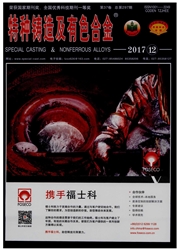

 中文摘要:
中文摘要:
采用Sn-Pb—Bi低熔点合金模拟钢液对高频电磁场作用下中间切缝圆坯连铸结晶器内的弯月面行为进行研究,从弯月面形状、高度和三相点位置等方面入手分析,讨论了电源功率、感应线圈位置和磁场频率对弯月面行为的影响,并以钢液为试验材料进行模型试验,验证了采用Sn—Pb-Bi低熔点合金进行研究的可靠性。结果表明,电功率对弯月面行为影响较明显;感应线圈的最佳安装位置位于结晶器切缝区域中心;在20~30kHz范围内增加磁场频率可以有效提高弯月面高度,但当磁场频率超过30kHz后,弯月面高度增加幅度不明显;在相似的试验条件下,钢液弯月面轮廓线接近于合金熔液的弯月面,这表明采用Sn—Pb-Bi低熔点合金熔液可以准确地模拟钢液的弯月面行为。
 英文摘要:
英文摘要:
Meniscus behavior in partial-slit type round billet continuous casting mold under high frequency magnetic field was investigated using low melting alloy Sn-Pb-Bi instead of liquid steel. Effects of power, installation site of induction coil and frequency of magnetic field on the meniscus behavior was studied on base of meniscus shape, height and triple point position. Furthermore, model experiments with liquid steel were conducted to validate reliability of the results obtained through the experiments using Sn-Pb-Bi. It is found that the meniscus behavior is influenced significantly by power of electrical source. The optimal installation site of the induction coil is located in the center of slit zone of the mold. The meniscus height is increased as increase of frequency of magnetic field at the range of 20 kHz to 30 kHz. However, the rate of increase decreases when the frequency of magnetic field exeeeds 30 kHz. At similar experimental circumstances, the profile of liquid steel meniscus coincides approximately with that of Sn-Pb-Bi which indicates that Sn-Pb-Bi can be used to simulate the meniscus behavior of liquid steel.
 同期刊论文项目
同期刊论文项目
 同项目期刊论文
同项目期刊论文
 期刊信息
期刊信息
